The island of Bali is arguably the shining star of Indonesia. It’s somewhat true, but it varies based on the location. If we exclude the well-known beaches and areas, we wholeheartedly support this assertion. One of those places we agree with is the town of Ubud in the north of the island.
Ubud is the must-see area of Bali. Whoever is coming to Bali should definitely stay at least 2 or 3 nights in Ubud.
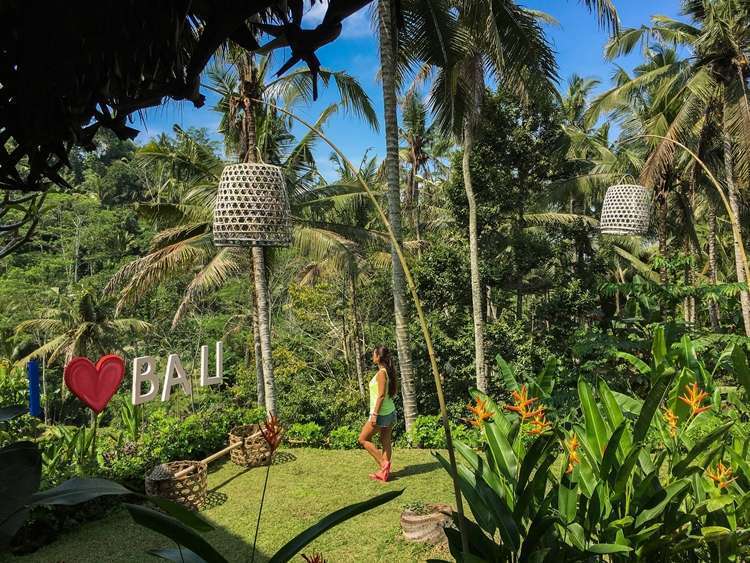
Just as people who crave vibrant crowds gravitate towards Kuta and Seminyak, surf enthusiasts seek their thrills in Kuta, Canggu, and Uluwatu. When it comes to Ubud, it embodies the spirit of yoga, health-conscious dining, a deep bond with nature, and a vibrant tapestry of culture. How do you define Ubud?
Ubud is one of the top tourist destinations and one of the most visited places in the world. It is world-renowned for creativity, natural beauty and relaxation.
We advise you to explore our articles titled “All About Bali” and “Choosing Your Ideal Ubud Accommodation” before your trip to Ubud.
THINGS TO DO CENTER OF UBUD AND NEIGHBORHOOD
We’ve marked the places to visit in the heart of Ubud and its immediate vicinity with green pins on the map for your convenience.
Ubud Monkey Forest
A short motorbike ride from Ubud’s downtown, you’ll find the Monkey Forest, named for its resident primates. Beyond monkey sightings, you can enjoy a leisurely forest stroll for a few hours. This sanctuary isn’t just a tourist hotspot; it’s a crucial hub for research initiatives, contributing to global studies on monkey social interaction and behavior.
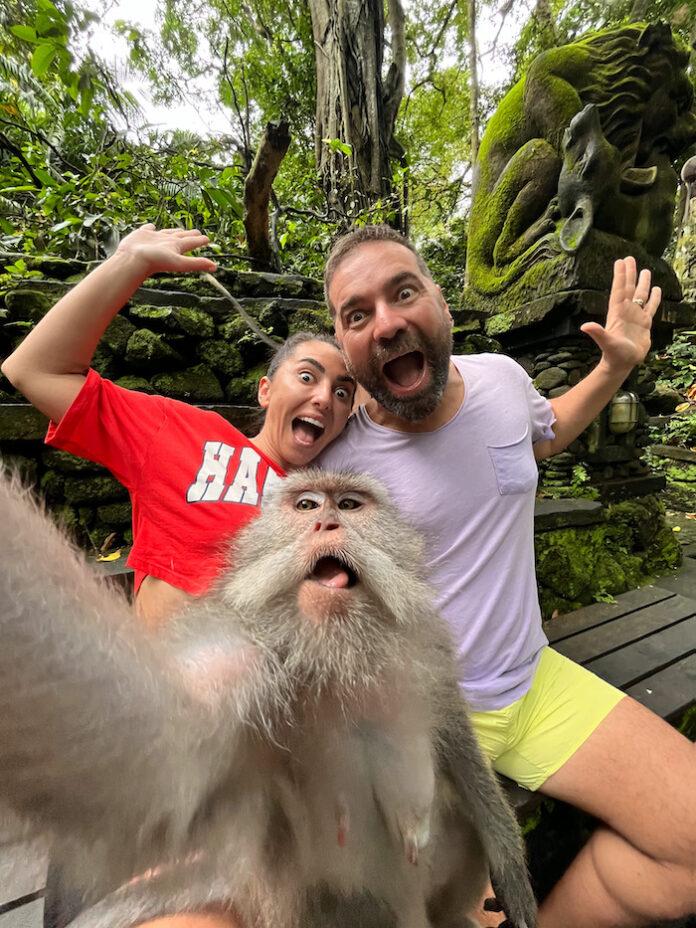
- Before entering the forest, check the rules to be followed on the signboard.
- If you have plastic bags, bottles and similar items with you, do not forget to give them to the ticket office.
- Monkeys are generally uninterested in approaching you unless you have bananas or other snacks to share. If you’d like to interact with them, there are trained attendants who can assist. They offer a service for a small fee, taking your phone and capturing a selfie of you while providing peanuts to the monkeys.
- In the interest of the monkeys’ health, please refrain from giving them biscuits, bread, peanuts, or any unhealthy junk food.
Address : Jalan Monkey Forest – Padangtegal – Ubud – Gianyar- Bali
Visiting Hours : 08:30 – 18:00
Entrance fee IDR 80.000
Ubud Palace / Puri Saren
The Ubud Palace, a significant site in Ubud, was erected in the 1800s, featuring the distinct Balinese architectural style. It once served as the royal residence for the King of Ubud. You might wonder why a palace exists in Ubud. The answer lies in Ubud’s history, as it held royal city status for approximately a century, thus justifying the construction of this splendid palace.
During the evening, you can witness an enchanting Balinese dance performance that occurs each day. Tickets for the show are conveniently available for purchase from the venue’s staff at the entrance.
Pura Taman Saraswati
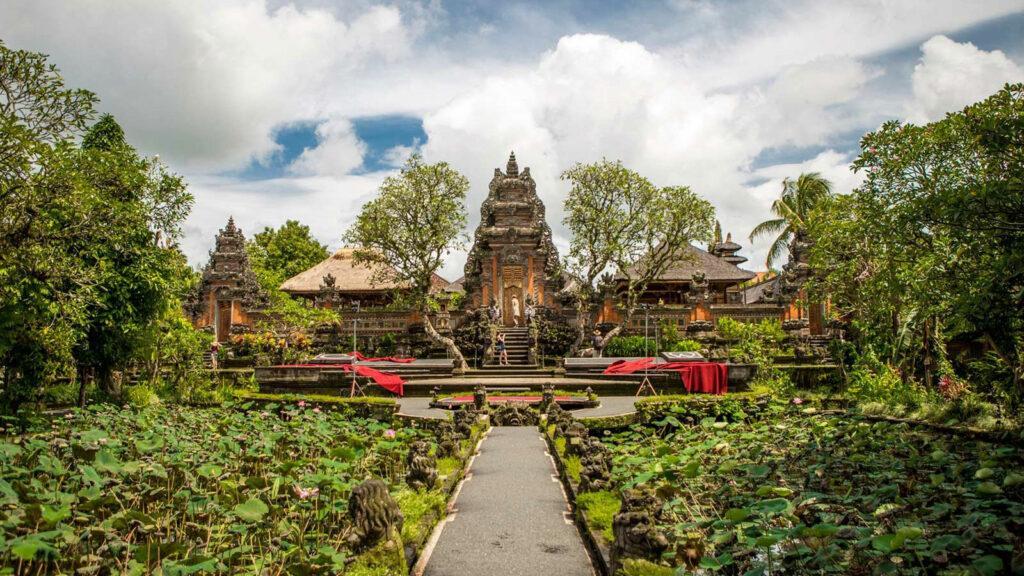
Found at the town center, just 200 meters away from Ubud Palace, this temple is a water palace, often referred to as the Lotus Lake Temple. Its remarkable feature includes the temple’s serene pools and the profusion of lotus flowers adorning them, setting it apart from other Balinese temples. The temple was built in the name of Saraswati, known as the creator god.
The temple, where you will see the Balinese architecture very clearly, will be a very good choice for taking photos and visiting its surroundings. There is no entrance fee.
We’ve encountered blogs that describe Ubud Palace by incorporating this image. It is not Ubud Palace.
There’s a charming local cafe situated by the lake, with a Starbucks on the opposite side. Surprisingly, not many are aware of the lovely garden tucked behind Starbucks. We highly recommend enjoying your coffee in this tranquil setting. Similar to the Ubud Palace, this temple hosts dance performances on specific days of the week. During our visit in May 2023, we had the pleasure of attending a captivating dance show at the Pura Taman Saraswati temple.
Chairs are placed left and right. If you go early you have the chance to sit in the front row. Initially, we occupied chairs, but later we opted to sit on the floor in a belly-down position at the center. This spot provides a prime vantage point for enjoying the dance performance. So, if you don’t mind sitting on the floor, we recommend securing a spot here.
Goa Gajah / Elephant Cave
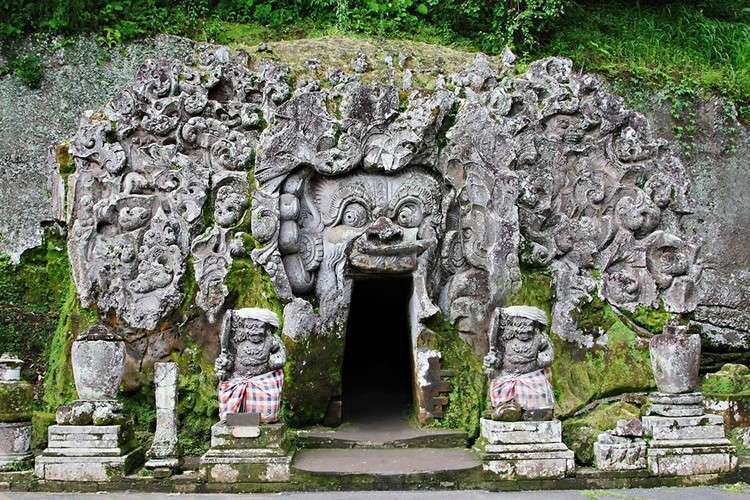
The cave, whose name is a bit surprising, is a remarkable archaeological site that houses sculptures and stone carvings. With its origins tracing back to the 11th century, Goa Gajah holds a sacred significance as a place dedicated to meditation and spirituality.
The name is surprising. The cave is intriguingly named “Goa Gajah,” despite the absence of elephants in the vicinity. While the exact reason for this name remains uncertain, there are various speculations and theories surrounding it.
Situated on the western outskirts of Bedulu village within the Gianyar district, this temple is just 6 km away from the heart of Ubud. After visiting the temple, you should definitely see the waterfall inside.
Visiting Hours : 08:00 – 16:00
2023 entrance fee 50.000 IDR
Sangeh Monkey Forest
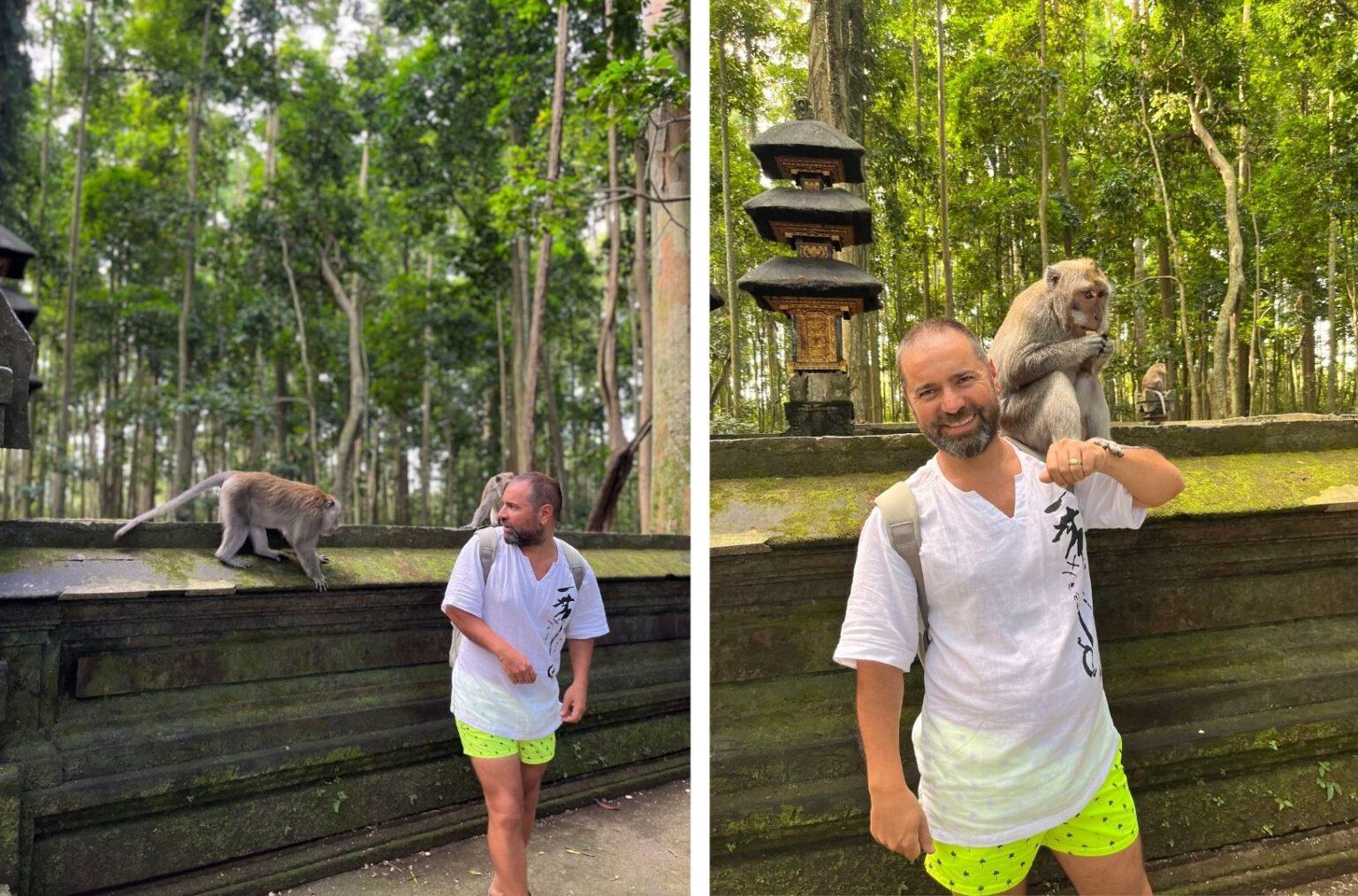
During all our past trips to Ubud, a visit to the Monkey Forest in the heart of the town was a must. However, on our latest visit, we made a conscious choice to explore various other areas of Ubud. One of them was the Sangeh monkey forest, which we had always passed by but never had the chance to visit. Compared to Ubud Monkey Forest, the monkeys living here are more wild.
Upon your arrival at the entrance, you will certainly be greeted by the presence of guards. Do not prevent them from accompanying you. Otherwise you will not be able to visit on your own. Thanks to the guards, we visited the monkey forest easily and with their guidance. At the end of the tour, don’t forget to tip the guard as much as you wish. Although this place has a smaller trail than Ubud Monkey Forest, it is not as touristic as Ubud Monkey Forest. As such, it is very enjoyable to visit.
Tegenungan Waterfall
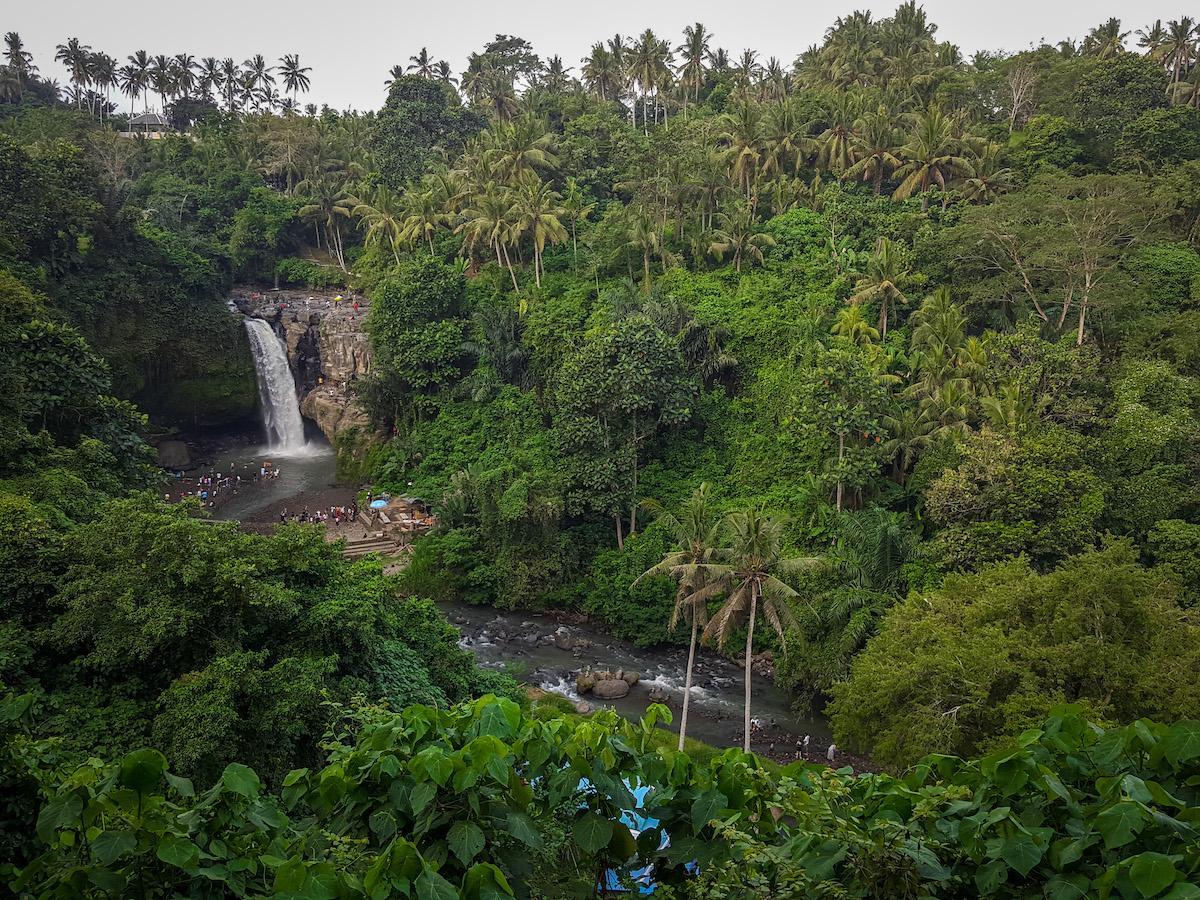
It is a waterfall very close to Ubud. You have to descend steep steps to reach the waterfall. We added it to the list because it is around Ubud. It is not a must-see waterfall.
It is 10 km south of Ubud center. It is in Tegenunyan village. Entrance fee 20.000 IDR
Kanto Lampo Waterfall
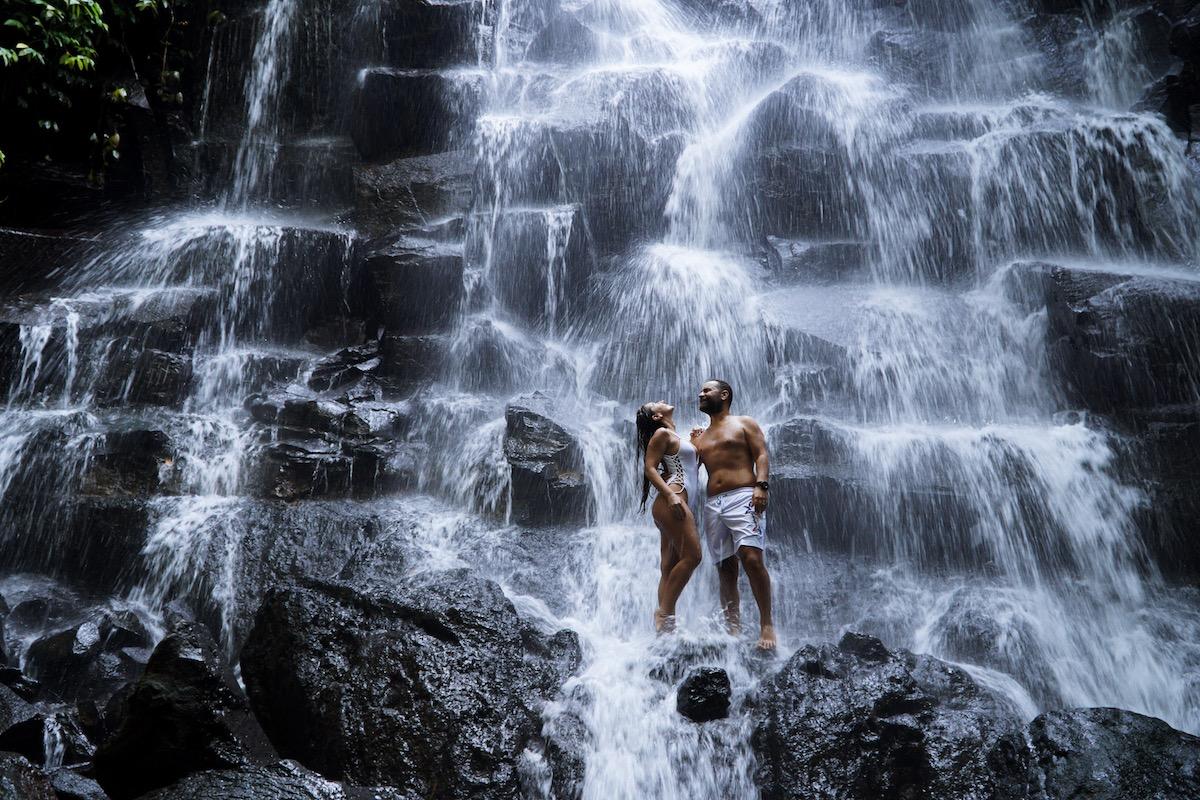
This is one of our favorite waterfalls in Ubud. Accessing it involves descending a significant number of stairs. At the end of the stairs there is a pond area where the waterfall flows. When the water level is elevated, it can rise above your waist. You can leave your belongings in a corner of the stairs and go to the main waterfall flowing into the pond. Like in many places across Bali, you’ll also find a bustling crowd of tourists here. Unfortunately, you will have to wait in line to take the photos you see. The waterfall is not suitable for swimming!
Entrance fee 10.000 IDR
Tibumana Waterfall
Another waterfall near the heart of Ubud is Tibumana Waterfall. While it may be smaller in size, the pool at the base of the waterfall provides an ideal spot for taking a refreshing dip.It is not crowded like other waterfalls.
Entrance fee 10.000 IDR
Taman Beji Griya Waterfall
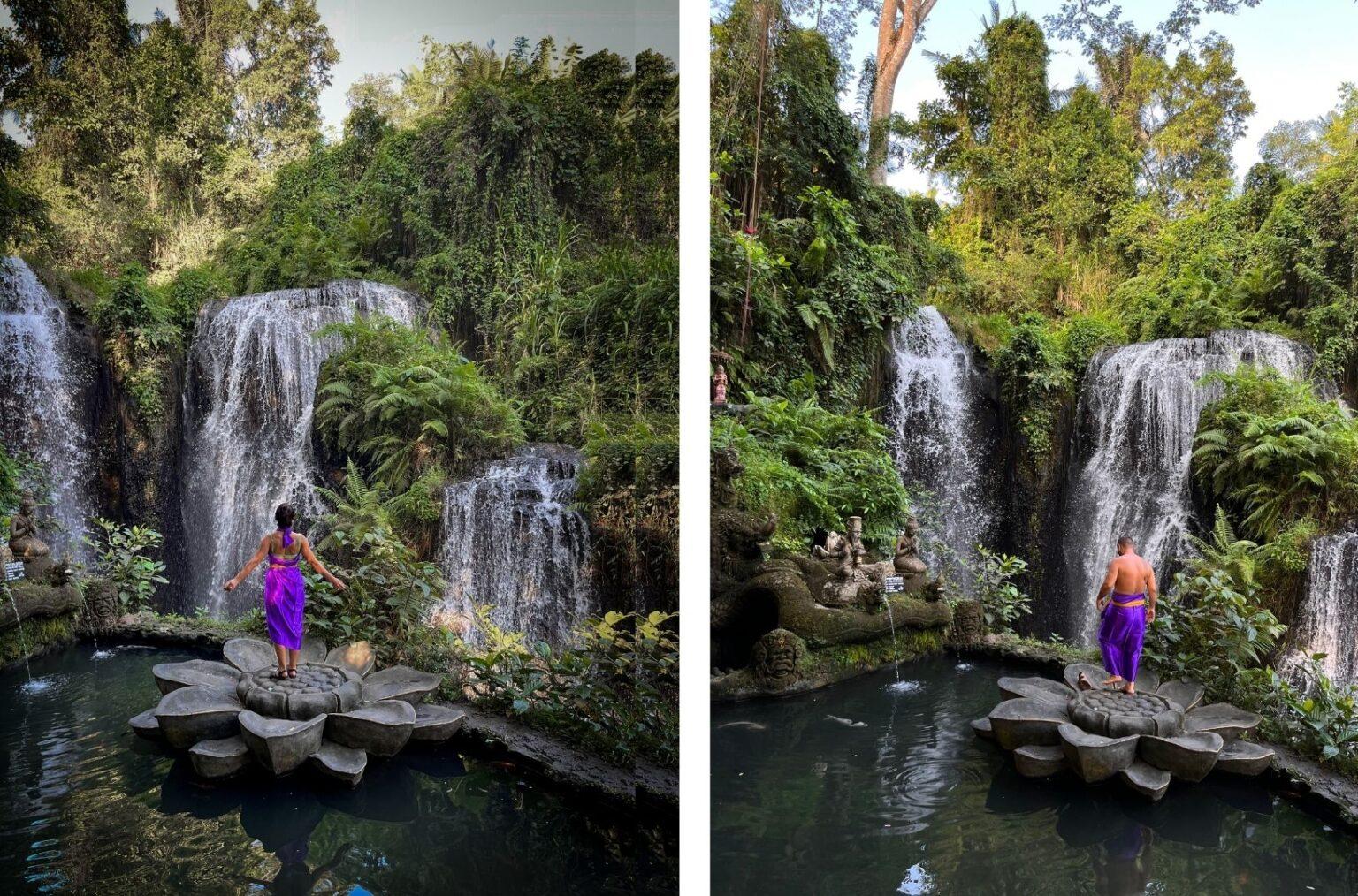
While often labeled as a waterfall, Taman Beji Griyi is, in fact, a spiritual healing center. If you’re interested in taking part in the ancient Balinese purification ceremony known as Melukat, an entrance fee is required. Melukat is a sacred ritual aimed at cleansing the mind, body, and soul. Led by a priest, it involves reciting prayers, making offerings, and concluding with a purifying bath in the revered waters, believed to rid the body of impurities.
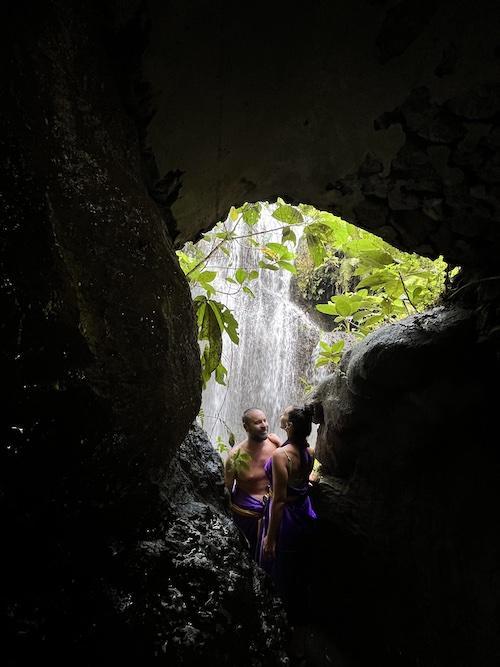
Whether or not you opt for the purification ceremony, as you arrive, you’ll be adorned with a purple shawl and sash, and you’ll be asked to leave your bags and personal belongings outside. If you have the time, we highly recommend participating in the ritual for a truly unique and enriching experience.
2023 entrance fee 100.000 IDR
THINGS TO DO IN THE NORTH OF UBUD
The list of places to visit in the north of Ubud is pinned in orange on the map.
Terunyan Village
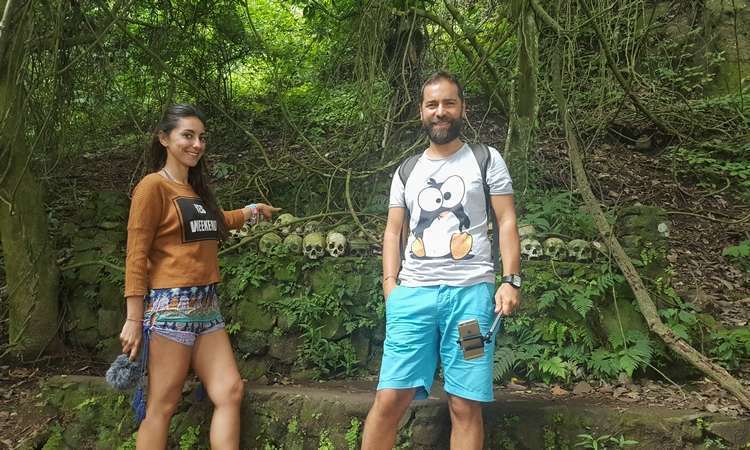
It is one of the oldest villages on the island of Bali. The village situated to the western shores of Lake Batur, the largest lake on the island of Bali, is renowned for its unique burial traditions. All the bones and skulls are on the ground. The big tree in the cemetery, which you can reach in 20 minutes by boat from the village, is called Taru Menyan. Taru means tree and Menyan means fragrant. According to the locals, this tree effectively prevents the odor of decomposing bodies from dispersing. We went to witness it firsthand and can confirm that it’s indeed accurate.
You can read our Terunyan Village article here.
Penglipuran Village
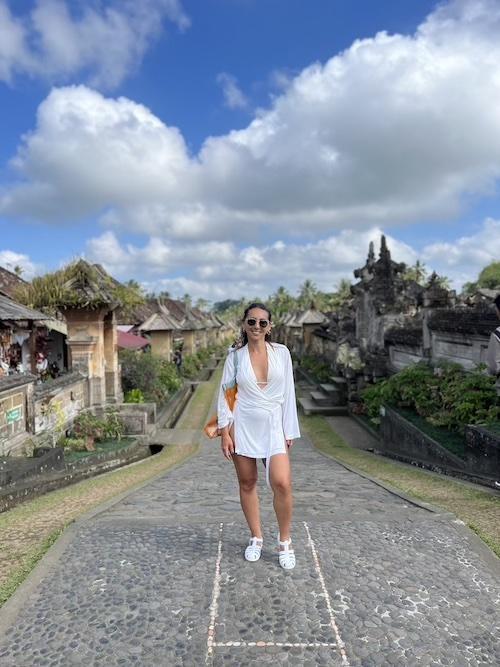
It is the best preserved traditional village in Bali. Penglipuran has earned recognition as one of the top three cleanest villages worldwide. If you get the opportunity to visit, you’ll undoubtedly observe this distinction. It’s worth acknowledging that this is quite a popular tourist destination. If you plan to go to Tukad Cepung or Krisik waterfall, we think you should see it even if it is just a quick trip as you will be very close to Penglipuran.
Entrance fee 50.000 IDR
Goa Raja Waterfall – Tukad Cepung Waterfall
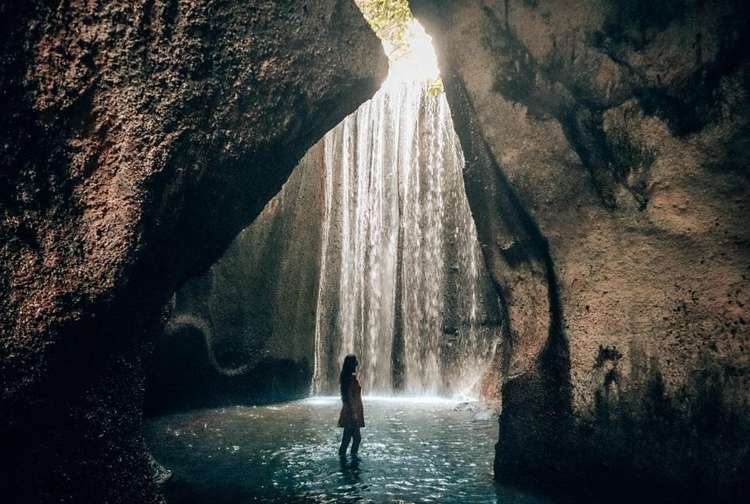
The distance between both waterfalls is 4.5 km. If you are going to choose between the two, we recommend Tukad Cepung. Especially since this waterfall flows between the rocks, the ambiance when the sun hits the waterfall from the hill is completely different. But we would like to emphasize that it is very crowded.
Krisik Waterfall
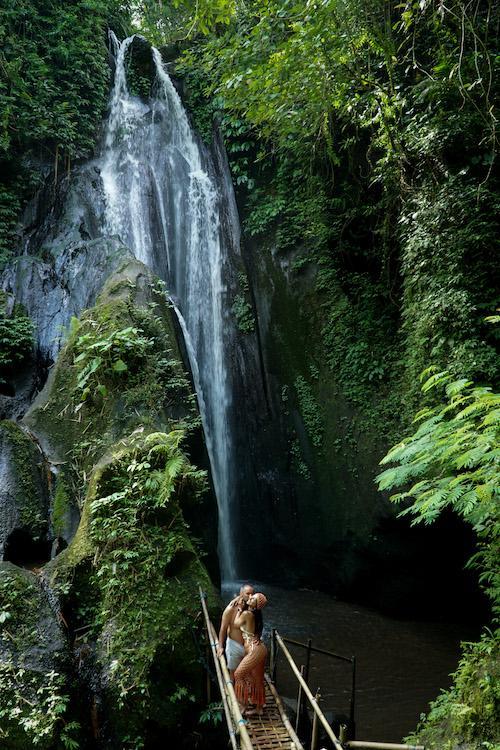
When we saw dozens of motorcycles and parked vehicles in the parking lot of Tukad Cepung waterfall, we realized how crowded it was inside, so we decided to give up and go to Kritik waterfall. Since we had never been there before, we asked the shopkeepers in the parking lot if they would recommend us to go to Kritik waterfall to avoid any surprises. Although they all advised us not to go, we decided to go. I am glad we didn’t listen to the locals and went.
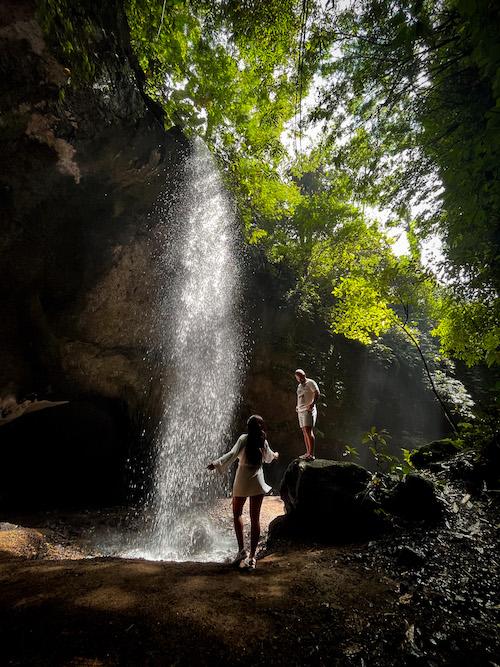
There are two waterfalls in Krisik. One of them is a thin flowing waterfall and the main one is reached by a wooden bridge. After descending the stairs, when you see the signboard, it takes you to the thin flowing waterfall on the left. If you continue to the right, you reach the main waterfall with a wooden bridge. You can continue directly to the right to save time.
Mount Batur
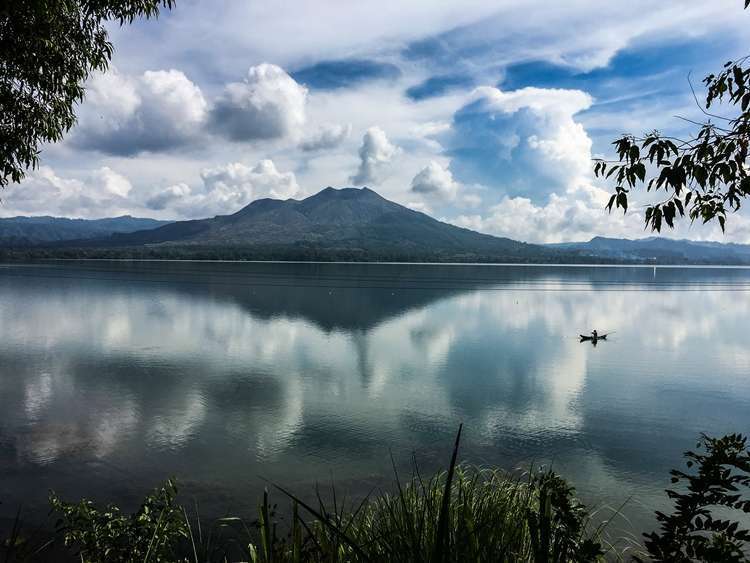
Sometimes you come across insatiable landscapes, and this is one such place. Mt. Batur is a small stratovolcano (conical shaped volcano) 1,717 meters high in the north of the island of Bali. More than 20 eruptions have occurred over the last two centuries. You can join sunrise trekking tours to Batur, the most active volcano on the island of Bali, or you can watch this unique view from the opposite shore of the lake.
Tegallalang Rice Terrace
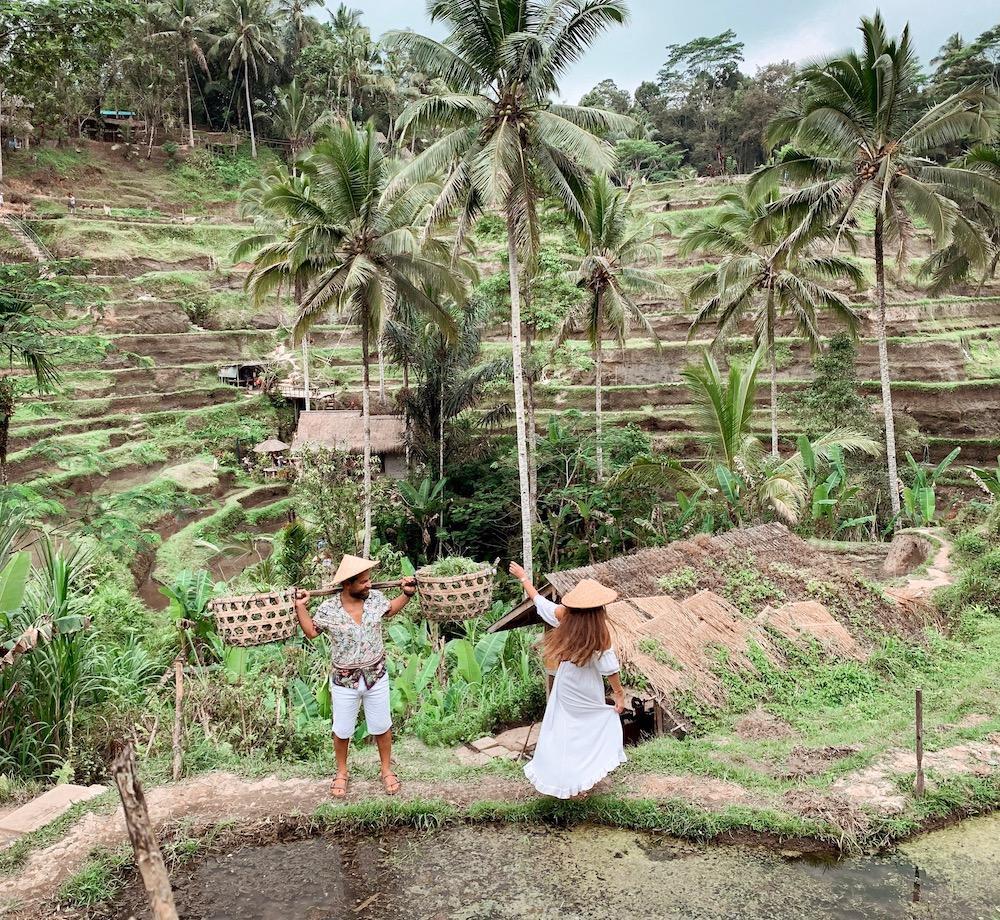
Tegallang is the most spectacular of Ubud’s must-see rice fields. The magic of the rays reflecting on the fields at sunrise and sunset will impress you. As soon as you see this place, the rice fields of Yunnan in China and Sa Pa in Vietnam come to mind. Okay, we admit that it is not as magnificent as them, but at least it is close. Even if you are not going to enter the rice field, take a break for 5-10 minutes on the road and watch and photograph the view from the hill!
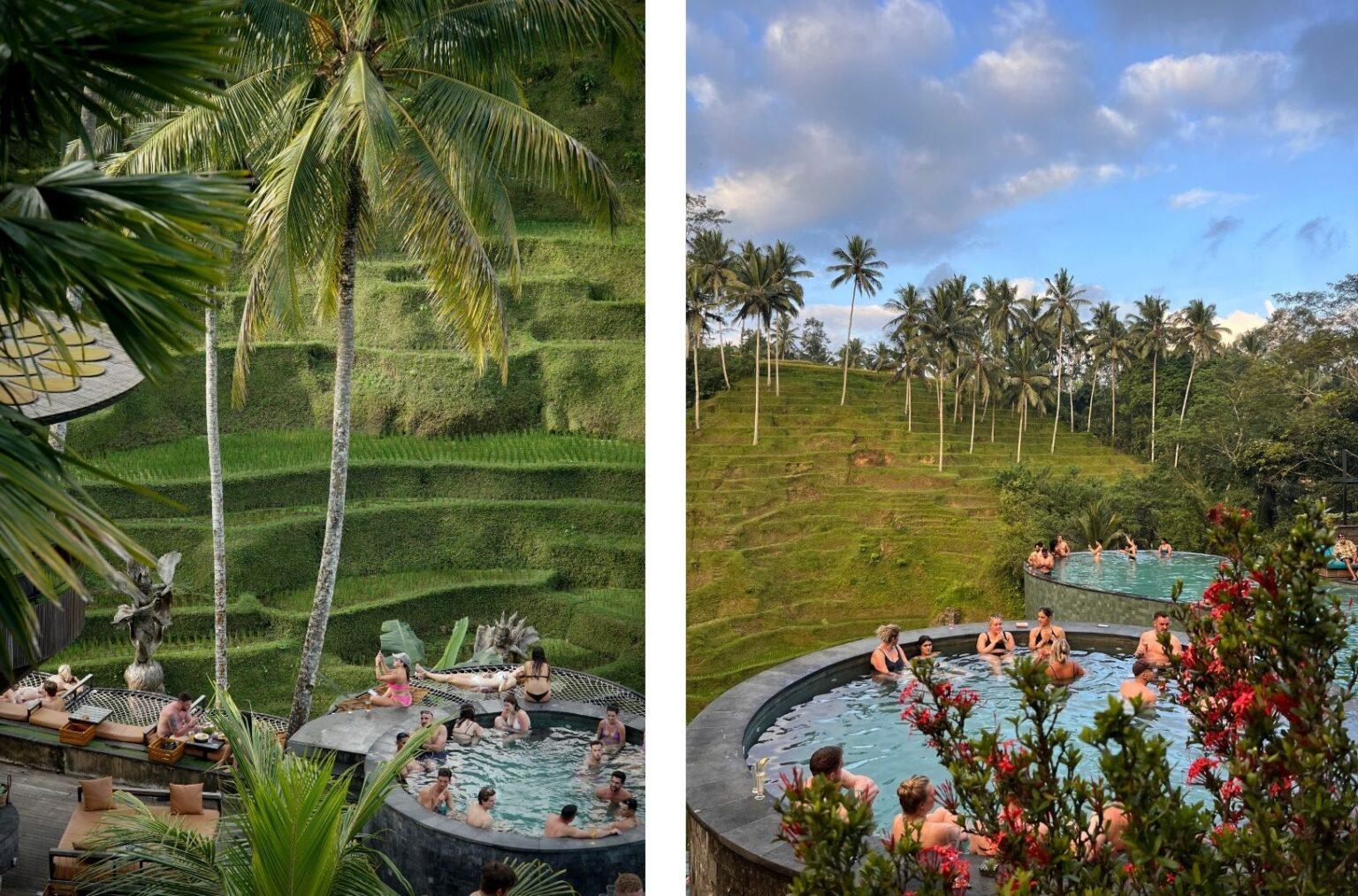
The best place to spend time in the rice fields is Alas Harum. Within Alas Harum, you can spend time in the infinity pool with a view of the rice terrace and a DJ performance in the place called Cretya. Those who wish can swing on a swing over the rice fields. There is also a glass terrace area where you can taste Kopi Luwak coffee. You can find out the entrance fee, lodge fee, coffee tasting fee, swing and other activity fees on the Alas Harum page.
Jatiluwih Rice Terrace
atiluwih is one of the less preferred places to visit. We don’t know if this is because it is less known or because it is far from the center. But we would like to say that it is as big or even bigger and more beautiful than Tegallalang. After all, it is not on the Unesco World Heritage List for nothing.
Tirta Empul Temple
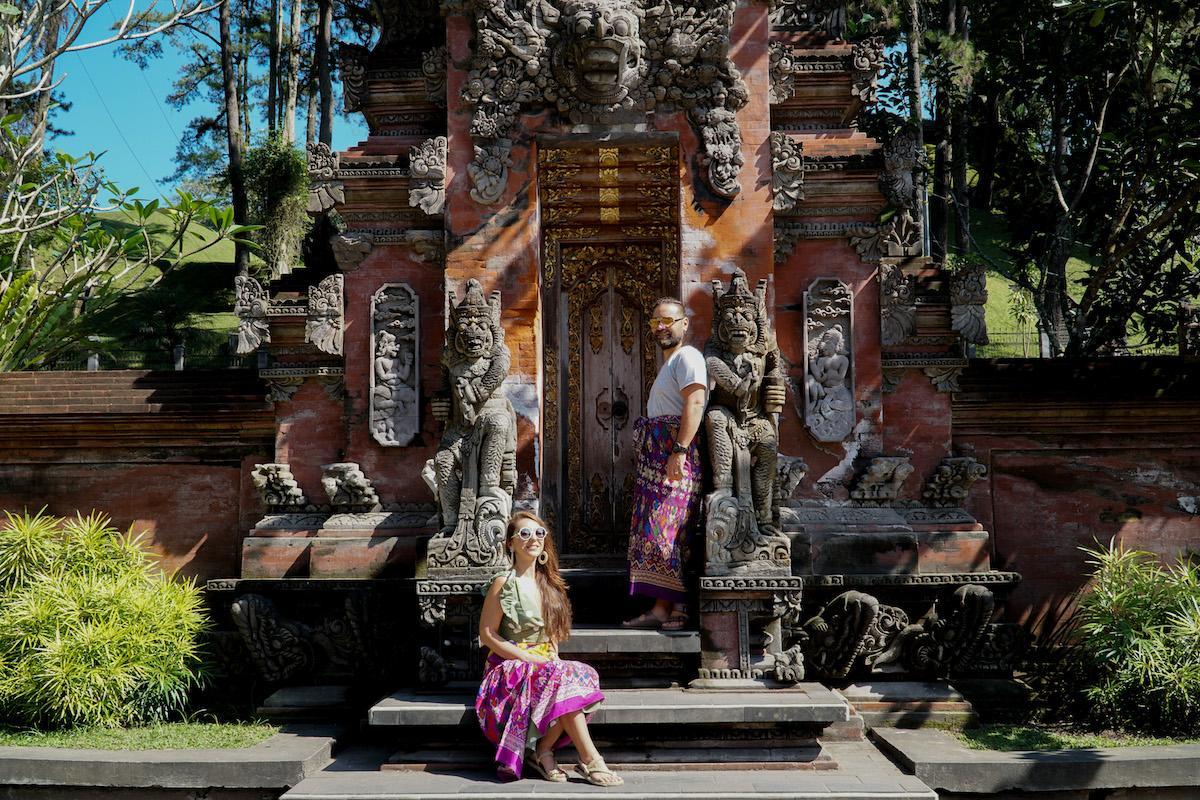
The water temple of Tirta Empul is a sacred water spa for Balinese Hindus. This is Indonesia’s largest and most populous water temple dedicated to the Hindu God Vishnu. The water source inside the temple was discovered in 962 AD. Its source comes from the Pakerisan river. The temple consists of three sections: back, front and center.
As soon as you enter the temple, you will pass through the large stone Bali gate (locally known as candi bentar) and arrive at the outer courtyard of the temple. This area of the temple is called jaba sisi. At the end of the courtyard, there is another candi bentar built into the wall leading to the central courtyard.
This gate is guarded by neatly carved huge statues of two Dwarapalas or guards who have been given a golden colored brush. At the top of the gate is a carving of a Kala, which is quite different from other Kala carvings as it has teeth sticking upwards and a pair of hands with open arms.
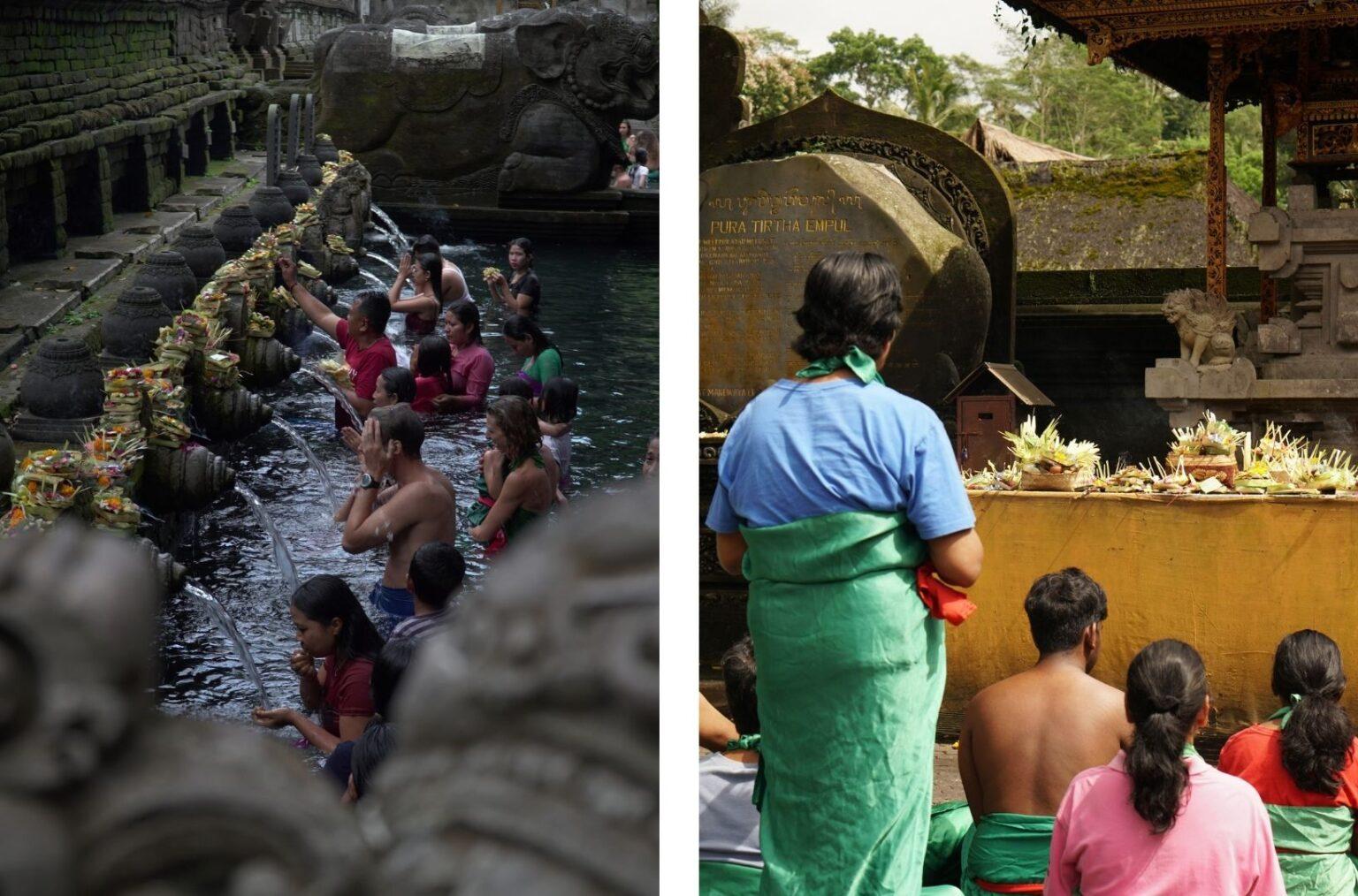
As you enter the inner courtyard you will arrive at the jaba tengah area, the main area of the temple. Here the sacred springs turn into a large, crystal clear pool inside the temple. This purification ritual is known as melukat. There are a total of two pools and 30 running water taps in the central location. Hindu people come here to go under the holy water and perform ceremonies. Of course, this does not necessarily mean that Hindus will enter. If you want to enter as a tourist, no one prevents you. Balinese people have been coming here for more than 1000 years and purifying under the holy water.
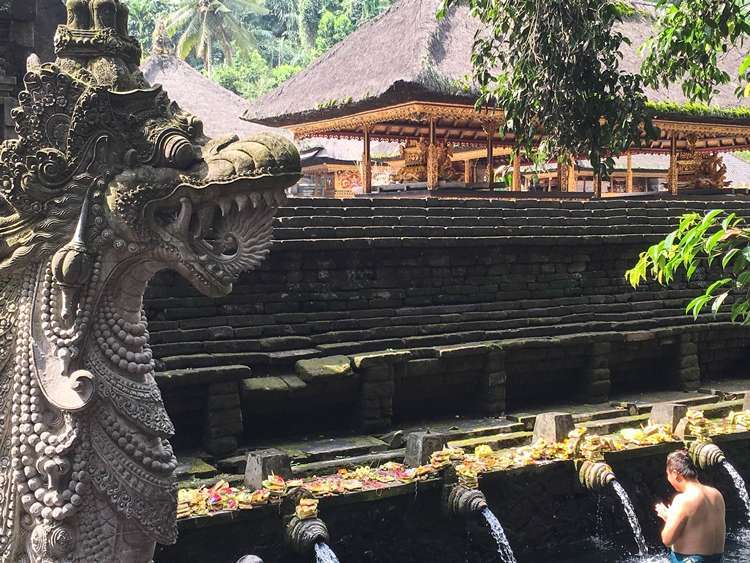
The pools behind the purification are the last part of Tirta Empul Holy Water Temple called jeroan (filled with green algae).
By the way, it goes without saying that you cannot enter the temples without sarongs. But as an additional information and a practice we have never encountered before was hair collection. You can’t enter the back section of Tirta Empul without a hair bun. The guards warn you to collect your hair at the entrance. On our 2023 visit, tires were placed in the area where hair is collected. Even if you don’t have a hairpin, you can collect it with the tires here.
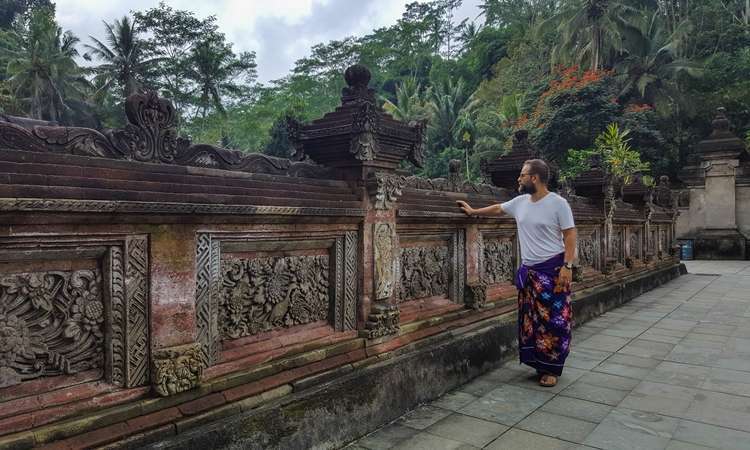
-The Myth of Creation-
The creation myth, based on a manuscript called Usana Bali, tells of an epic battle between a powerful but evil king named Mayadenawa and a God, Bhatara Indra. The king did not believe in God and forbade his subjects to worship God. The king had spiritual powers and misused them to cast a spell. So a priest prayed to God that the King would stop the war. Then God and his warriors came against the king, fought and deposed him.
At night, when God and his army were asleep, the king sneaked in and made them a poisoned drink. When God woke up in the morning and saw that his army was dead, he struck the ground with his staff and pierced the earth, and a holy spring of water was born. The dead army was sprayed with this water and brought back to life. This water source, believed to have healing properties and to be the source of life, became known as Tirta Empul.
The Balinese Hindu people commemorate Mayadenawa’s death every 210 days in the Balinese traditional calendar as the day when Virtue triumphs over Evil in a ritual and ceremony called Galungan.
Galungan Day: Once every 210 days you will definitely notice that you are surrounded by bamboo poles known as “penjor” all over the Island of Bali. Galungan marks the beginning of the most important religious ceremonies in Bali. The spirits of deceased relatives who have died and been cremated return to visit their old homes. During this festival all Balinese return to their villages to spend time with their families and help with household chores by offering offerings and food.
Another thing that is typical for this time of year is that you will see barongs roaming around the village. In every local village, Balinese walk around with the barongs at dusk to scare away evil spirits and protect the village against anything bad.
The temple is in the village of Tampak Siring in Manukaya district. It is a 30-minute drive from Ubud.
2023 entrance fee 50.000 IDR
Pura Gunung Kawi
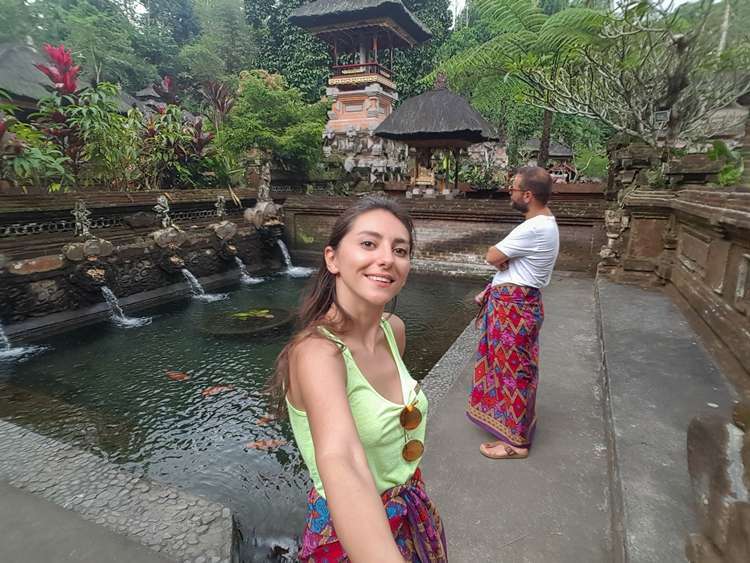
This is another water temple that looks very old in appearance, but this is due to its neglect. It is not possible to understand why Gunung Kawi is left like this while other popular temples are given so much attention, care and maintenance.
2023 entrance fee 50.000 IDR
Ulun Danu Beratan
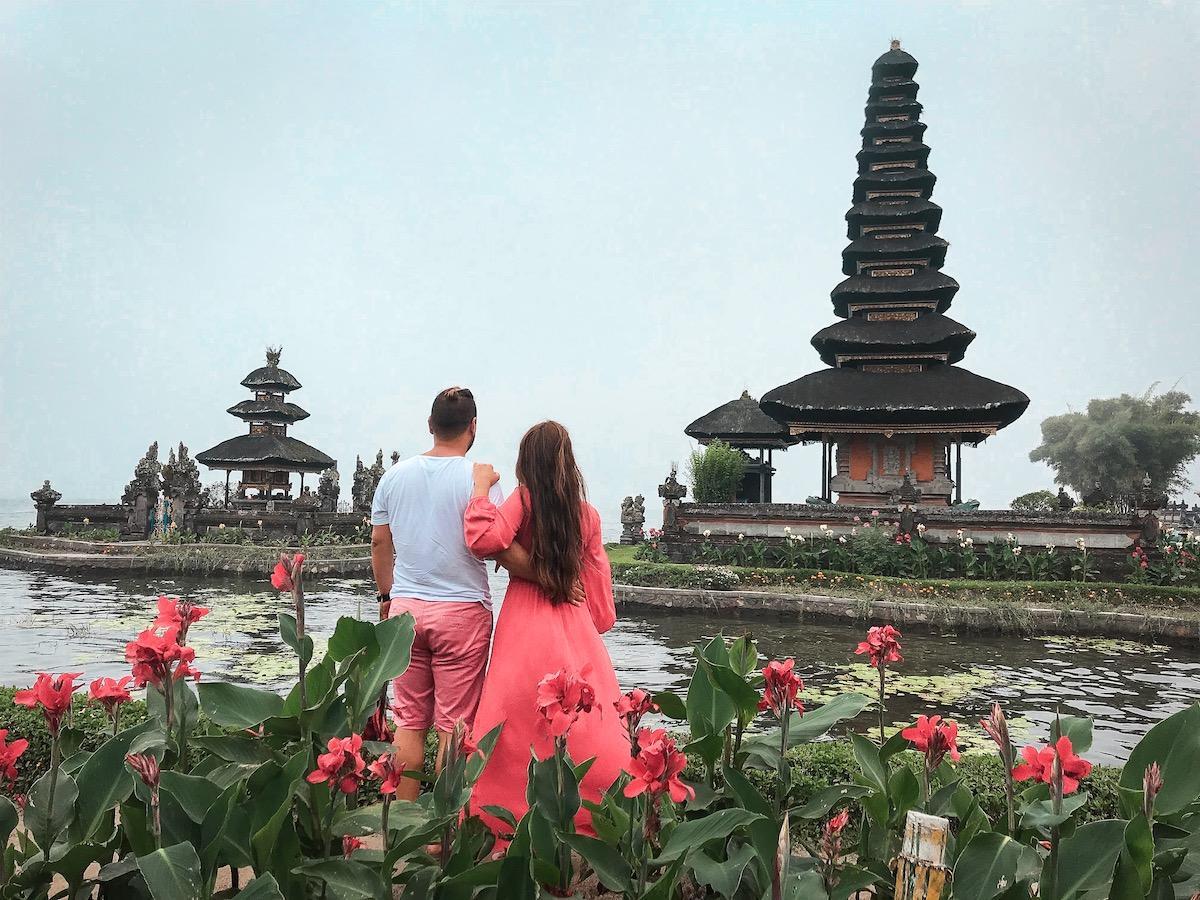
Ulan Danu is a water temple, also known as Pura Ulan Danu Beratan. Located at the tip of Lake Bratan Bedugul, Ulan Danu is the most famous Hindu temple on the island of Bali. The temple, also called the water temple, is almost floating on the lake. Information about its history shows that it was written on papyrus according to archaeological findings and historical records.
The sarcophagus and stone panel in the left front courtyard of the temple are findings from the megalithic period (500 BC). Ulun Danu Beratan, which has become a symbol of the island of Bali, is one of the first places to visit.
Entrance fee 75.000 IDR
Visiting Hours : 08:00 – 18:00
Address : It is located in the western part of Lake Beratan, in the Bedugul region.
Handara Gate
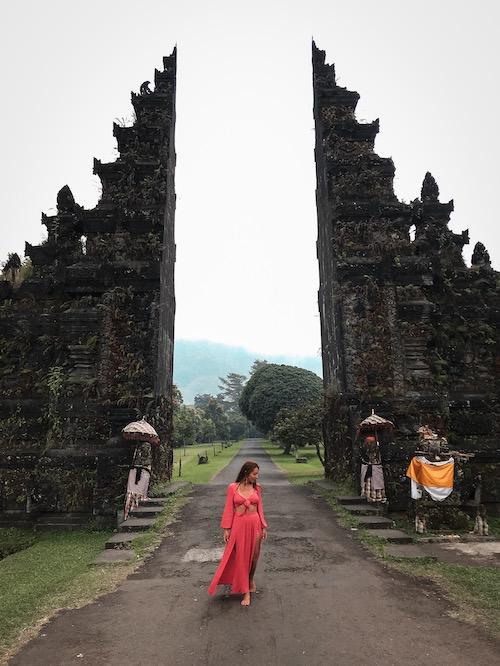
Handara gate is a traditional Hindu gate. The entrance to the golf center is one of the most photographed and shared places in Bali. Since we have been going back and forth for years, we have also observed how the demand has increased over the years. Before, when we used to leave Ubud center for our daily route, we would stop in front of Handara Gate, take a few photos and continue on our way.
Over the years, people’s demand for this place has increased. Naturally, long queues started to form in front of the gate. As a result, nowadays people are being charged for taking photos. If you are going on a route to the north of Bali, you will inevitably pass by this gate. You can take a photo or not, it’s up to you. But if you are curious, you can stop for a few minutes and see the gate.
Git Git Waterfall
17 km north of Ulan Danu, you can reach the waterfall, which is the most beautiful of the majestic and impressive Bali waterfalls, flowing in all its glory from a height of 40 meters. After entering, you can walk 15 minutes on foot along the pathway. At the entrance, if you have your camera with you, do not take it out of your bag, otherwise there is a separate fee for it.
Sekumpul Waterfall
Spanning 1,300 km² and flowing 100 meters high, the waterfall consists of a total of seven waterfalls. The waterfall, also known as Gerombong Falls, is located in the north of the island of Bali, 76 km from Denpasar.
Banyu Wana Waterfall
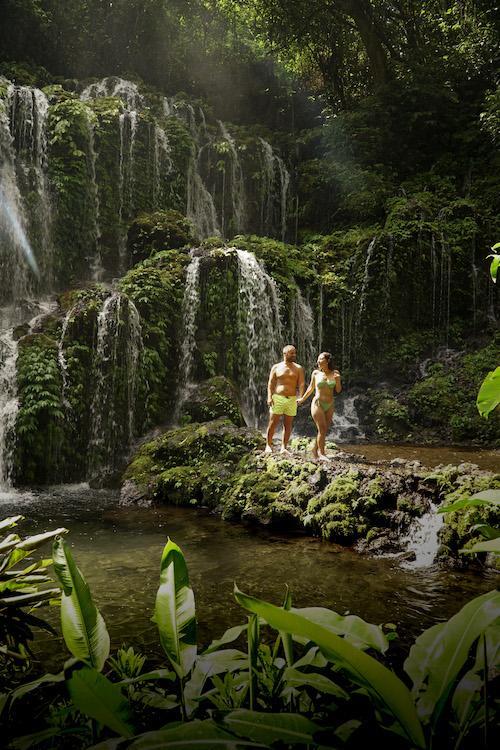
One of the waterfalls we visited in the North was Banyu Wana Waterfall. After parking our motorbike at the entrance of the waterfall and paying the entrance fee, we started walking downhill. They have made a paved path for the forest that is very comfortable to walk. Those who do not want to walk can rent a motor taxi from the entrance point.
Likewise, if you tell the staff below that you want a taxi on the way back, they will notify you upstairs and immediately direct a motorcycle. There are two waterfalls here. We preferred to go to the one on the left after the signboard appeared.
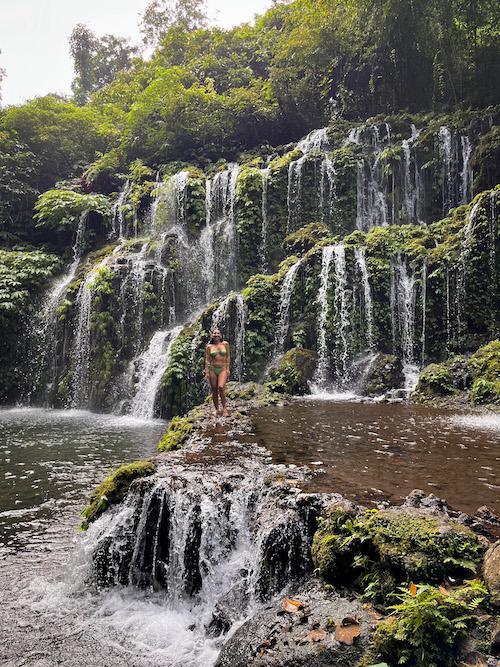
If you are going to come to this area, we recommend other waterfalls in the immediate vicinity: Banyumala Twin Waterfalls, Aling Aling, Fiji Waterfall (very close to Sekumpul waterfall) and Nung Nung Waterfall further south. A little south of Nung Nung is Leke Leke waterfall.
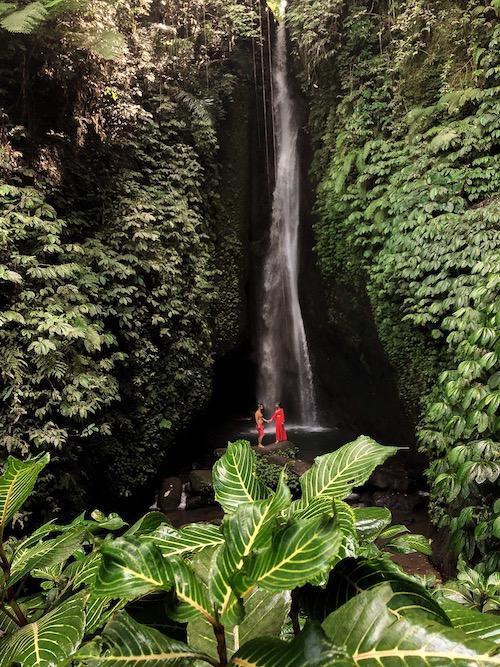
Another reminder is that if you are going to rent a motorbike, make sure you wear thick clothes. The altitude increases as you go north of the island. We recommend that you even wear gloves as you will also get wind while using a motorbike.
OTHER PLACES TO VISIT IN UBUD
You can visit all of the places listed below in one full day. One way from the center of Ubud is 88 km. If you take into account the return, it is 176 km. We do not recommend renting a motorbike. Because it would be a really tiring distance. Your only remaining option is to rent a car with a driver.
Besakih Temple
The largest and most sacred temple on the island of Bali is known as Besakih “Mother Temple”. Built on the slope of Mount Agung, the temple is a complex of 23 separate temples and was inscribed on the World Heritage List in 1995. Said to have been built in the 14th century, locals say it was built in the 11th century.
Entrance fee 60.000 IDR
Transportation : It is 30 km east of Tirta Empul.
Tirta Gangga Water Palace
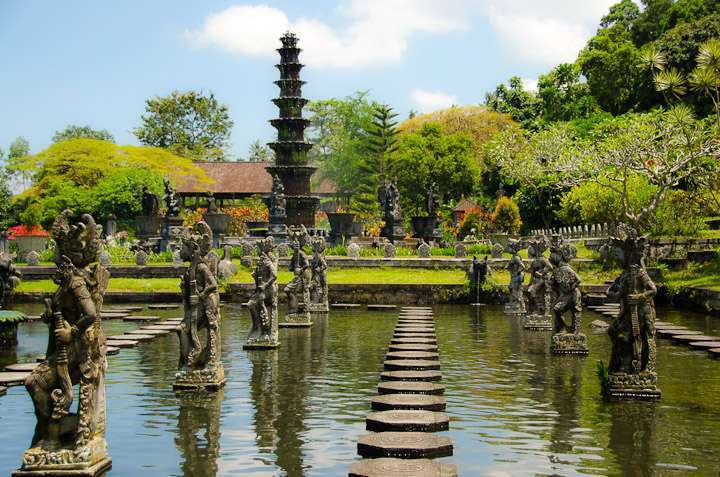
Tirta Gannga means water from the Ganges river. Built by the Karangsem Kingdom in 1940-1950, the temple was severely damaged by the eruption of Mount Agung in 1963. After the damage, the temple was restored to its present form with a serious restoration work. The 11-story fountain, the statues in the pool and the surrounding landscape draw you into the magic.
Entrance fee 50.000 IDR
Pura Lempuyang Temple
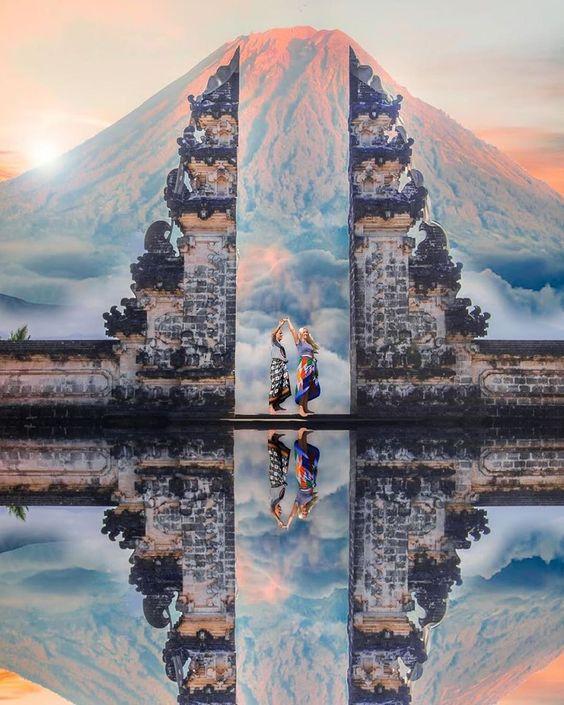
It is an ancient Hindu temple in Karangasem in the east of Bali. It is also one of the most ironic places in Bali. Visitors set off at dawn to take photos here. Keep in mind that there will be a line no matter how early you arrive. It is useful to set off at 5 in the morning to be there. If you arrive later than the specified time, you will wait in line for 2 hours. If you arrive towards noon, this waiting time increases up to 3-4 hours.
Dress Code: It is mandatory to wear a sarong when entering the temple. A sarong is a piece of fabric that wraps below the waist. And your shoulders must be covered.
Entrance fee 100.000 IDR
Lahangan Sweet
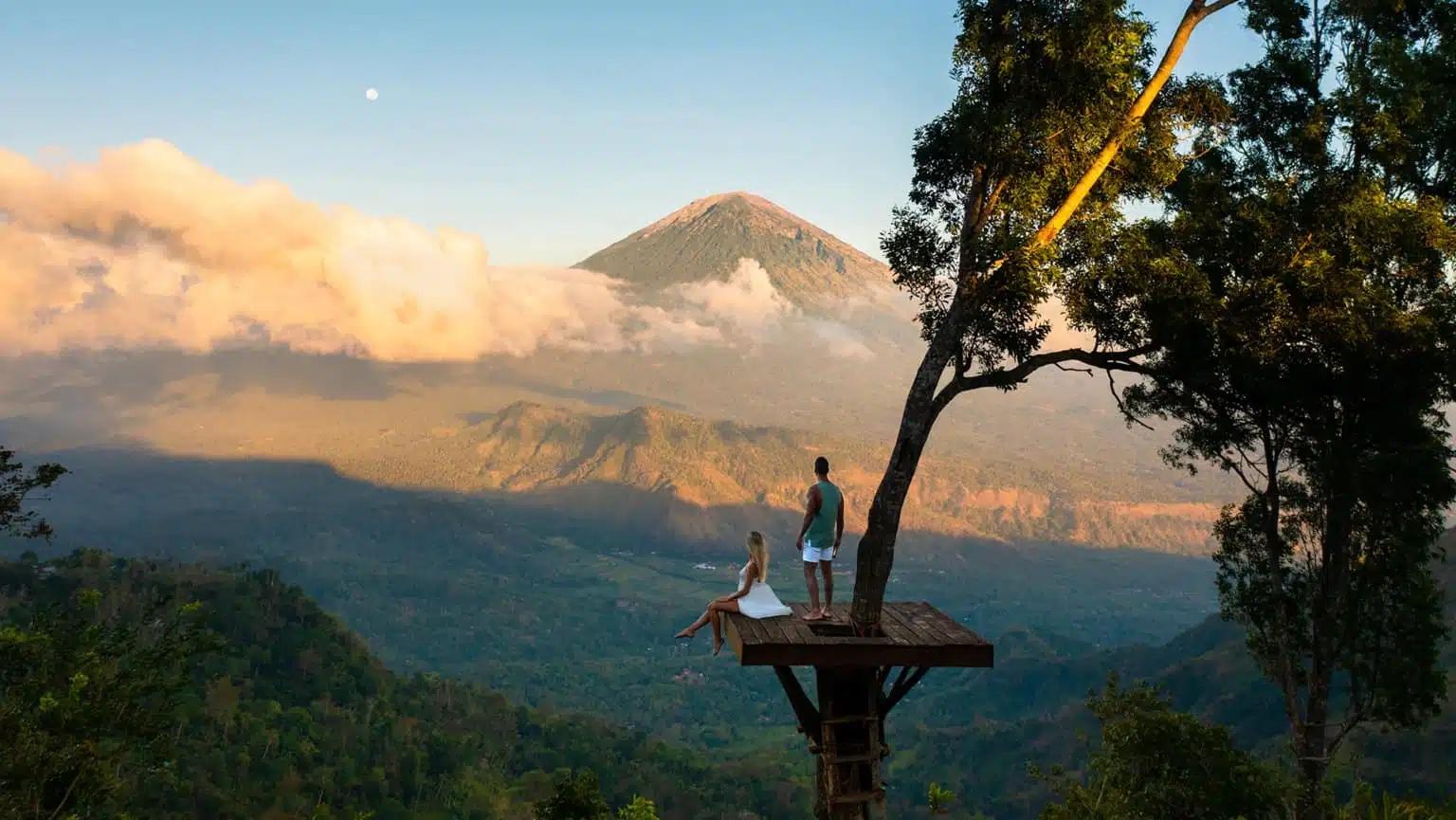
The best view of Agung volcano in Bali is from the Lahangan Sweet viewpoint. This is also located in the Karangasem area in the east of Bali. The best time to visit is at sunrise or sunset. If you are going to Lempuyan Temple, you can leave it for the evening. If taking photos at Lempuyan is not essential for you, then you can go to Lahangan at sunrise.
For a cloudless, clear sky, the best time to visit is during the dry season from March to November.
After you see the wooden sign that says Lahangan Sweet, if you are coming by motorbike, you will need to park your motorbike here and walk for 10 minutes. When you walk down the path, you will see the platform fixed to the tree.
Since it is a dirt road, do not forget sneakers for climbing, sweatshirt and drinking water as the weather is likely to be cold.
Entrance fee 30.000 IDR
Air Terjun Kuning
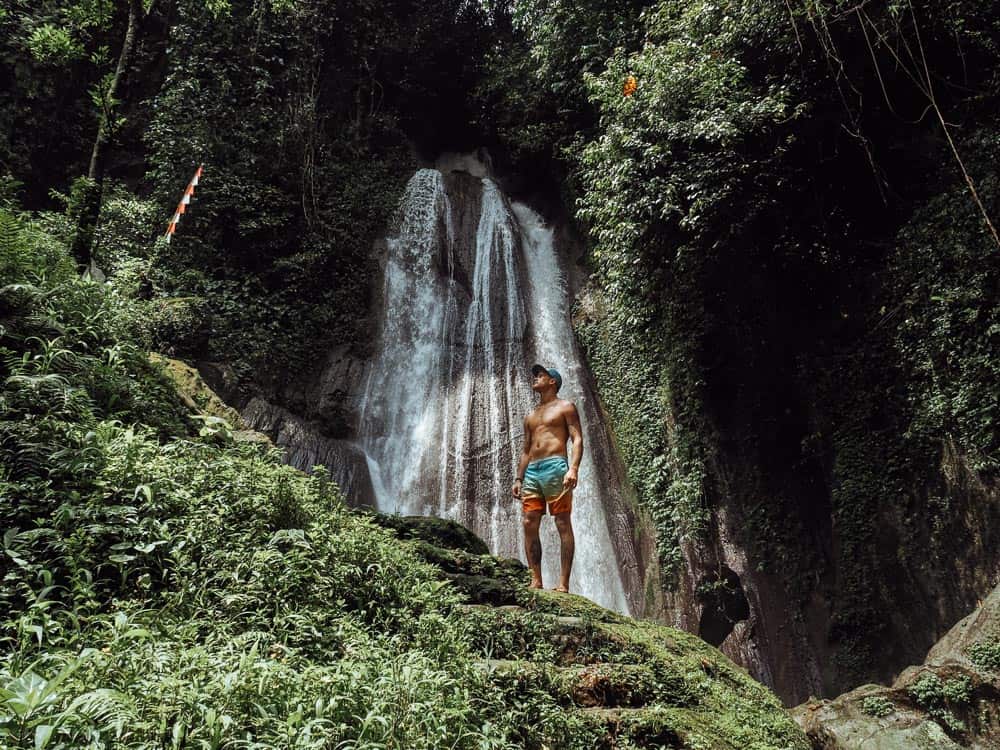
We have come to the end of the list of places to visit in the east of Bali. After visiting the above places, you can visit Air Terjun Kuning waterfall on your way back. This waterfall is not very crowded because it is far from Ubud. It is a magnificent waterfall flowing quite high for the greenery. It also gives you the opportunity to enter the water as it has natural ponds.
UBUD HIKING TRAILS
Ubud rice fields have been in existence since the 9th century. The best way to discover the magical and unique side of the rice fields around Ubud is to walk around them. There is no doubt that you will come across traditional village life and natural landscapes during your trip.
Ubud hiking trails have become very popular day by day. Since it offers more options to its visitors with its multiple routes, you do not stick to only one route. Since each route has different kilometers, it is up to you which one you prefer and trekking.
Do not forget to take water, hat, sunscreen, sunglasses and some money with you before trekking. The cafes and restaurants along the route will meet your needs when you want to sit and relax.
Campuhan Ridge Walk: It is a 2-hour trekking trail. You will have the chance to see countless villages along this trail, passing through rice fields and wooded areas. The trail is one of the most well-known and popular routes as it is often walked by local people and European tourists. Early morning or late evening is the best time for trekking.
You will cross the corner of Ubud Traditional Market towards the bridge. Before reaching the bridge, go through the Warwick IBAH sign and head towards the parking lot. At the entrance of the parking lot, you will see the Warwick Ibah sign again. Going to the hill is written under that sign. If you follow the direction, you will arrive directly at the Campuhan trail.
Sari Organic Walk: Rather than Campuhan, on this trail you will see and pass through more rice fields. The trail is very easy so you will not have any difficulties.
From the corner of Ubud Traditional Market on Jl. Raya Ubud on the right side of the road. If you follow the Sari Organik sign, you can easily reach the trail.
JI.Kajeng Walk: In fact, this route is the most authentic of the hiking trails. During your walk you can see temples, hotels, restaurants, farmers and animals.
Don’t miss Ubud
Go to yoga schools,
Join cooking schools,
Stay in hotels outside the center of Ubud,
For Luwak coffee,
Visit the temples,
Trek through rice paddies
